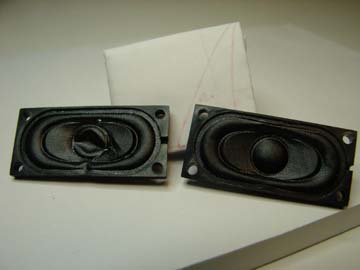Speaker and Continuity Tester for Universal Lab Bench
The assignment for class was to begin the process of making a fab-labable lab test bench that can
be downloaded from the internet and recreated around the world. This bench includes instrumentation
that functions as: an oscilloscope, a volt meter/multimeter, a resistance and capacitance meter,
logic analyser, etc. I am partnered with Ken Avery and our goal was to make a speaker and a
continuity tester--such that when we find a continuous signal, such as voltage, the speaker will beep.
Ken did the lion's share of this project. First we made Neil's Hello3 step response
board, and Neil's Hello5 speaker board-- using a 9 volt battery. Ken stuffed and we and programed the boards.
We found that the speaker kept burning out -- actually generated some smoke-- everytime we hooked it up. In
short shrift, it would burn out entirely. We realized that we were using a 5V regulator that could
not handle the 9 volt infusion. So we turned to the 5V LDO regulator and that seemed to help- we stopped
burning out speakers so quickly. We did however still experience a drop in power/signal to the speaker
over time. Turns out that when we initially programed the board, the power surge was higher than 5V (or so we think)
and only after programming, was the voltage regulated at 5 volts. So Ken programmed the board before
attaching the speaker, and that seemed to work better.
 |
Burned out speaker vs. new speaker
Next Ken tried to marry the two boards into one board. After quite a struggle with placing the parts reasonably
on the board without crossing signals, he succeeded. I too attempted to place the parts, and came up with
a version that requires a jump. I like his better. We milled the new board and found that there were some parts
of the board where the copper leads merged. He carefully hand milled/scratchhed these sections, and did succeed in
getting a single board for both functions. (I have recreated this as well.) After stuffing the board and programming
it alternately with each program, the board works.
Schematic, board for merged board and stuffed, complete board.
Schematic, board for merged board requiring jump, a la lass. Not quite ready for
prime time.
KEN: The good news is that both programs do what they out too when the chip
is programmed. the bad news is that the serial port does not seem to supply
sufficient power to run the speaker. when i power the board with the 9V the
speaker works fine. when i try to use the serial port to drive it, nada.
which would be fine but in order to run the other program it seems to need
power from the computer and not from another source. some com seems to be
happening via the power line that prevents the program from running when
powered by the battery.
A few hours later:
well, the board that had up and running crapped out so i'm back to having
two boards, one that outputs a tone (i slightly modified the pwm .asm
file to make it a constant beep as opposed to a ramping spound. The other
board, based on hello3 works too. when looking at the data we the value of
y[0] seems to actually capture continuity. its less than 511 when there's
no continuity and greater than 511 when there is continutiy. i have no
idea what that value actually represents but if i can figure out how to
extract it from the rather complicated looking code in the .py file. we
should be set there. as for tying the beep into it... it seems we should
be able to run a jumper between the boards that will allow for com between
them. this would entail adding a zeener diode and resister to the pwm board.
will try that next.






